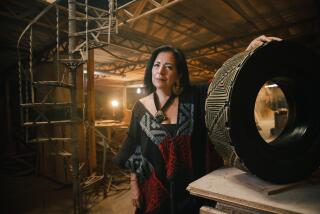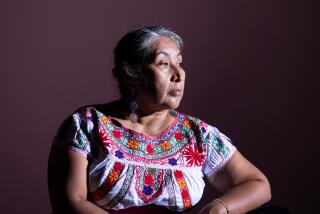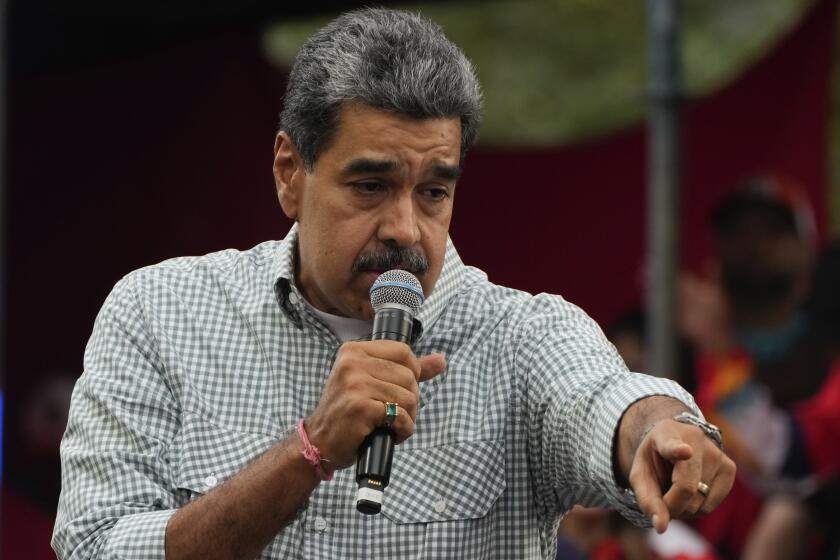‘The Human Landscape of Mexican Migration’
If you think that immigrant bashing is practically becoming an art form in America, you may want to stop by UCLA and inspect the literal evidence. The targets are hanging on display at the university’s Fowler Museum, life-size piñatas of half-human, half-rabbit creatures that practically dare you to pick up a stick and take a hard whack at them.
They belong to “Green, Go!” an exuberant yet unsettling installation by Maria Elena Castro that the Fowler commissioned for its exhibition “Caras vemos, corazones no sabemos/Faces Seen, Hearts Unknown: The Human Landscape of Mexican Migration,” running through Dec. 28.
Consisting of about 80 works by 40 artists, “Caras vemos” takes its title from a Mexican folk saying that refers to the way we look at people’s exteriors without perceiving their thoughts or feelings.
That’s the way many Americans tend to look at the millions of immigrants from Mexico and Central America who’ve flooded across the Southwest U.S. border in recent years, says John Pohl, the museum’s curator of the arts of the Americas. “We see these people on the streets and all over the U.S.,” Pohl says, but “people tend to not really understand who they are.”
“Caras vemos” attempts to shift that perspective with works that are variously humorous, satirical, folkloric, aggressively political or, like “Green, Go!,” all these things at once. Castro, 34, who was raised in a Spanish-speaking Mexican American household in Riverside, says that her piece was heavily inspired by her father, who was born in the United States but raised in the Mexican state of Sinaloa. Described by his daughter as a “happy, loud” man who loved Sinaloan banda music and helped construct papier-mâché figures for Easter week parades, he took equal pride in being both Mexican and American.
But despite its festive surfaces, there’s a dark undertone to “Green, Go!” (a pun on the word gringo, which itself is wordplay on the phrase “Green, go!” that was shouted by Mexicans at green-uniformed U.S. troops during the countries’ 19th century wars). The papier-mâché rabbit-humans, swathed in traditional Mexican thrift-store fabrics, appear to be menaced by a gaggle of shiny green, robotic-like extraterrestrials. At the back of the installation, presiding over the uproar, stands a pastiche of the Statue of Liberty and the Virgin of Guadalupe.
In exploring the issue of what makes someone an “alien,” Castro says she was influenced by her recent experience of becoming a first-time mother and her discovery of vociferous comments on anti-illegal-immigration websites. “I was in a very angry place with this work,” she acknowledges. “They say when you’re a mother your claws come out. That’s how I felt. I felt very protective of my daughter and of my father’s memory.”
Show migrated west
Drawn from the personal collection of Gilberto Cárdenas, a University of Notre Dame sociology professor, and curated by Amelia Malagamba-Ansótegui, a professor of Latino art history at Arizona State University, the exhibition was organized by Notre Dame’s Snite Museum of Art and the Institute for Latino Studies.
Several of the show’s best-known artists make their homes in Southern California, including Lalo Alcaráz, Gilbert “Magú” Luján, Gronk and Patssi Valdéz. For the Fowler version, a few additional works by well-known L.A. artists including Frank Romero were added.
Thematically, the show is divided into five sections that track the migrant journey, from the physical and emotional hardships of leaving Mexico and Central America to the challenges of U.S. assimilation.
Because “Caras vemos” includes work from the heyday of the Chicano movement in the 1960s and ‘70s through the present, it illustrates how these concepts evolved during a period when Latinos grew to become America’s largest “minority.” It also charts changes in artistic strategies, from cartooning and the updating of folk art forms such as votive candles and milagro tin paintings to video and Conceptual art.
Malagamba-Ansótegui says the show’s theme took on greater urgency after “Caras vemos” first opened at Notre Dame in 2006, a few months after the massive pro-immigration May Day marches in several U.S. cities that year. While previous art exhibitions have scrutinized the immigration theme, she says, they’ve tended to take a more sociological or anthropological angle that downplayed the artworks’ aesthetic qualities. “Caras vemos” reflects how Latin American and Chicano artists in places like Tijuana are expressing a viewpoint that’s intensely local but also aware of immigration’s worldwide impact, what she refers to as a “glocal” perspective.
One artist’s story
Ramón Ramírez, 36, who grew up as a truck driver’s son in East L.A., says he first began to identify with being a Chicano artist after seeing the landmark show “Chicano Art: Resistance and Affirmation, 1965-1985” in San Francisco in 1989, when he was a UC Berkeley student. The term seemed to fit the sense that he’d always had of growing up between two cultures, in a Spanish-speaking household where he taught himself English by watching television but still identified with his Mexican heritage. “Up until this day, I can sing probably about 10 Vicente Fernandez songs verbatim,” he says.
Ramírez says he thinks he owes “quite a bit” to pioneering Chicano artists such as Gronk and Magú. He appreciates that today there are more collectors of Chicano and Latin American art, and young Latino artists are allowed “to be more expressive.”
“It’s very easy to fall into the ‘Latino aesthetic,’ and, ‘oh, this is Ramón Ramírez and this is how he paints,’ ” the artist says. “I was hanging out with Magú two Saturdays ago, having a mental menudo, and he was pushing me, ‘Well, why do you do abstract painting?’ And I said, ‘I’ve always done abstract painting, as a little kid, even though I didn’t know what it was.’ ”
Although Ramírez often delves into politics in his paintings, his large painting in the show, “Coming Home” (2006), is one of his most personal. It depicts two contiguous houses, one pink, the other blue, that belong to his father’s family and are located in the small village in Jalisco, Mexico, where his father lived before migrating to the United States. An SUV is parked out front and the street is paved with real dollar bills, creating a powerful vision of how the traffic of money and humans between the U.S. and Mexico affects lives in both countries.
“I’m hoping next week to bring my father to the show,” Ramírez says, “so he can see the house he grew up in.”
More to Read
Sign up for Essential California
The most important California stories and recommendations in your inbox every morning.
You may occasionally receive promotional content from the Los Angeles Times.











